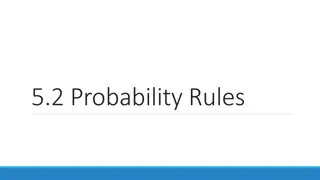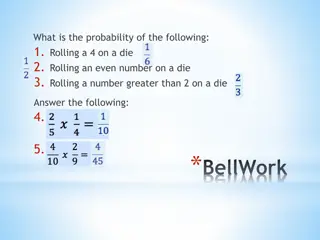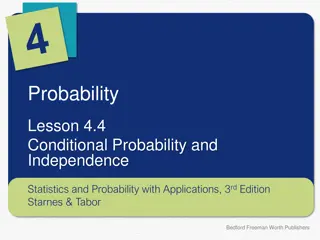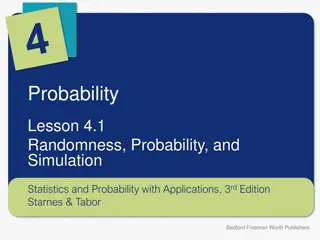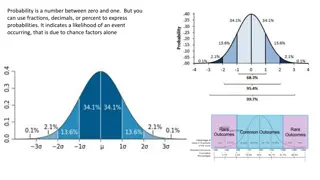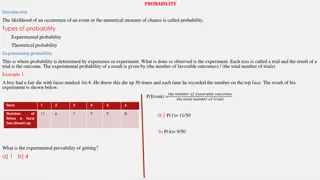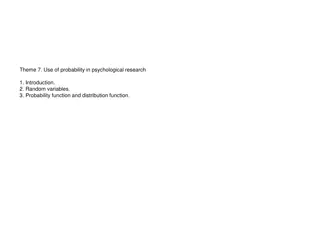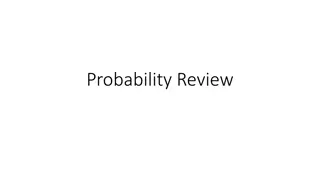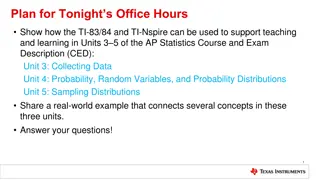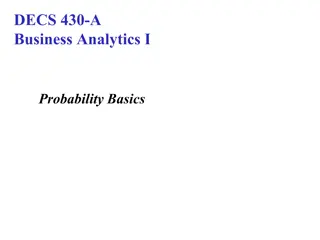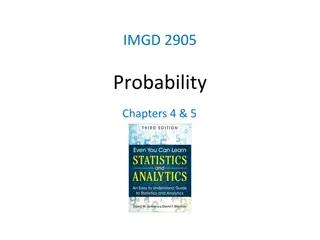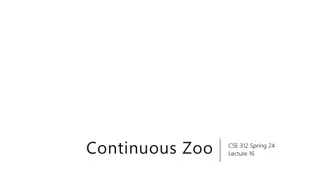Probability Concepts
In this study material, you will learn about sample spaces, theoretical probabilities, and experimental probabilities. Discover the basics of probability experiments, outcomes, and event sets. Explore the calculation of possible outcomes in various scenarios. Delve into the theoretical probabilities and favorable outcomes concept. Enhance your knowledge on determining probabilities and expressing them as decimals, fractions, or percentages.
Download Presentation

Please find below an Image/Link to download the presentation.
The content on the website is provided AS IS for your information and personal use only. It may not be sold, licensed, or shared on other websites without obtaining consent from the author.If you encounter any issues during the download, it is possible that the publisher has removed the file from their server.
You are allowed to download the files provided on this website for personal or commercial use, subject to the condition that they are used lawfully. All files are the property of their respective owners.
The content on the website is provided AS IS for your information and personal use only. It may not be sold, licensed, or shared on other websites without obtaining consent from the author.
E N D
Presentation Transcript
Bellwork Bellwork
Sample Spaces and Sample Spaces and Probability Probability Section 10.1
What You Will Learn What You Will Learn 1. Find sample spaces. 2. Find theoretical probabilities. 3. Find experimental probabilities.
Probability A probability experiment is an action, or trial, that has varying results. The possible results of a probability experiment are outcomes. For instance, when you roll a six- sided die, there are 6 possible outcomes: 1, 2, 3, 4, 5, or 6. A collection of one or more outcomes is an event, such as rolling an odd number. The set of all possible outcomes is called a sample space.
Find the number of possible outcomes in the sample space. Then list the possible outcomes. 1. You flip two coins. 2. You flip one coin and roll a six-sided die.
You flip a coin and roll a six-sided die. How many possible outcomes are in the sample space? List the possible outcomes.
Theoretical Probabilities The probability of an event is a measure of the likelihood, or chance, that the event will occur. Probability is a number from 0 to 1, including 0 and 1, and can be expressed as a decimal, from 0 to 1, including 0 and 1, and can be expressed as a decimal, fraction, or percent. fraction, or percent. Probability is a number
The outcomes for a specified event are called favorable outcomes. When all outcomes are equally likely, the theoretical probability of the event can be found using the following. The probability of event A is written as P(A).
Take Note Take Note
A student taking a quiz randomly guesses the answers to four true-false questions. What is the probability of the student guessing exactly two correct answers? Step 1 Find the outcomes in the sample space. Let C represent a correct answer and I represent an incorrect answer. Step 2 Identify the number of favorable outcomes and the total number of outcomes. There are 6 favorable outcomes with exactly two correct answers and the total number of outcomes is 16.
Step 3 Find the probability of the student guessing exactly two correct answers. Because the student is randomly guessing, the outcomes should be equally likely. So, use the theoretical probability formula. = 37.5%
Some probabilities are found by calculating a ratio of two lengths, areas, or volumes. Such probabilities are called geometric probabilities.
Using Area to Find Probability Using Area to Find Probability You throw a dart at the board shown. Your dart is equally likely to hit any point inside the square board. Are you more likely to get 10 points or 0 points?
3. You flip a coin and roll a six-sided die. What is the probability that the coin shows tails and the die shows 4? Find P( A). 8. In Example 4, are you more likely to get 10 points or 5 points? 9. In Example 4, are you more likely to score points (10, 5, or 2) or get 0 points?
Experimental Probabilities (Take Note) An experimental probability is based on repeated trials of a probability experiment. The number of trials is the number of times the probability experiment is performed. Each trial in which a favorable outcome occurs is called a success. The experimental probability can be found using the following.
Finding an Experimental Probability Finding an Experimental Probability Each section of the spinner shown has the same area. The spinner was spun 20 times. The table shows the results. For which color is the experimental probability of stopping on the color the same as the theoretical probability?
In the United States, a survey of 2184 adults ages 18 and over found that 1328 of them have at least one pet. The types of pets these adults have are shown in the figure. What is the probability that a pet-owning adult chosen at random has a dog? The number of trials is the number of pet-owning adults, 1328. A success is a pet-owning adult who has a dog. From the graph, there are 916
Determining Whether Events Are Independent Two events are independent events when the occurrence of one event does not affect the occurrence of the other event.
As part of a board game, you need to spin the spinner, which is divided into equal parts. Find the probability that you get a 5 on your first spin and a number greater than 3 on your second spin.
A bag contains twenty $1 bills and five $100 bills. You randomly draw a bill from the bag, set it aside, and then randomly draw another bill from the bag. Find the probability that both events A and B will occur. Event A: The first bill is $100. Event B: The second bill is $100.




